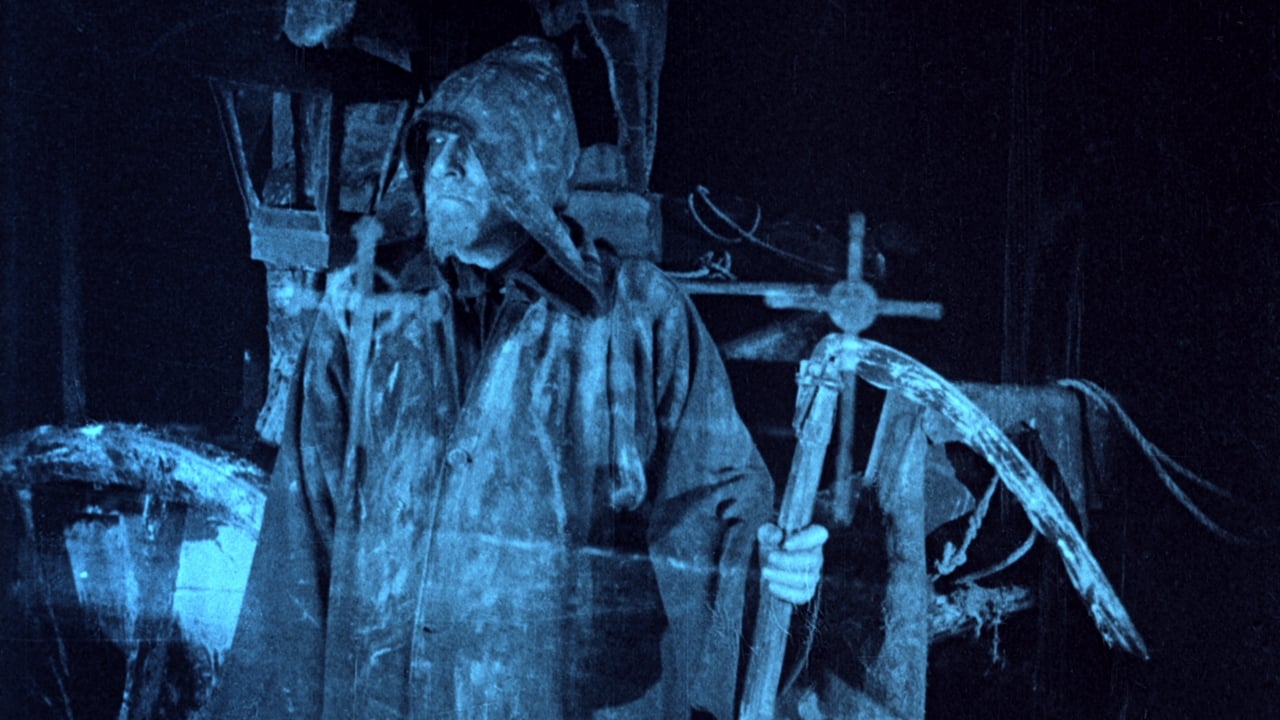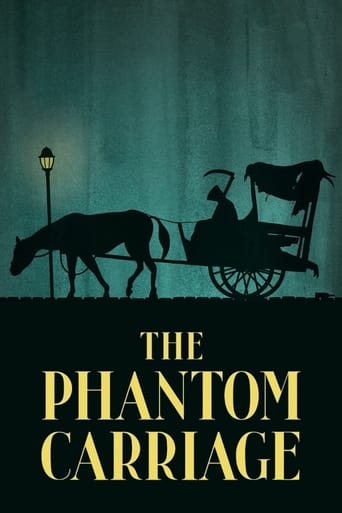

As were not uncommon in the silent era, The Phantom Carriage is a morality tale, meaning its whole purpose is to condemn the characters it has written, and use every frame to bring about their judgement, act God. The last person to die before midnight on New Years Eve attains the unenviable position of 'phantom carriage' driver for the next year - a ghostly horse drawn carriage that stops at the door of the newly deceased and takes them away. David is the character who suffers this misfortune here, though as things play out, it seems less like fortune and more like fate - the punishment handed to him for a life of drunkenness and immorality. While this is not a pretty rap sheet, I'm sure there were many did worse throughout the year, who had worse karma coming them, and were more deserving of the position, but hey, lets not let logic get in the way of fantasy. Throw in a melodramatic love story, and we see a film determined to live up to the definition of its genre in every way possible. The double exposures that achieve the ghostly carriage does make for a neat visual effect, but there is not a lot else going for it. It moves far too slowly, and could have been told in half the time.
... View MoreNot many people watch the old silent films these days, but for those that actually take the time to do so, sometimes, I think, those people carry a 'respect for the elderly' approach when assessing them. In other words, they give the film a certain degree of deference simply because the film is old. After watching "The Phantom Carriage," and seeing its lofty rating (currently 8.1/10), I think that is likely the case here. Having said that, going in I was fully prepared to like, or more probably, love The Phantom Carriage. I enjoy horror films in general and I have no qualms watching silent/old films, many are among my favorites. However, the films have to 'work' - or more simply - make sense, and this one just sadly does not. *Spoilers follow*The plot largely centers around a ne'er-do-well, David Holm, and the Salvation Army worker, Edit, who tries to help and redeem him. However, Edit shows an abnormal affection for and interest in David, despite only meeting him once or twice. Now, for one, there is no viable explanation for why Edit, the Salvation Army worker, should care SO MUCH for the miserable David; even to the point of proclaiming her love for this man that she knows literally nothing about, other than he is a contemptible misanthrope of the highest order. Hardly the stuff for inspiring undying love. So there is a real problem with that plot element that is never satisfactorily resolved or explained. Second, David's redemption comes about rather quickly, after witnessing his general barbarity for a good 90 minutes. Time and again he is shown to be an unfeeling brute, even to the point of carelessly endangering the lives of his own children. And then, in a flash, he is a new man. It's an incredibly quick turnaround for the cad that David was. Dickens handled this material much better in his "A Christmas Carol," a story that "The Phantom Carriage" borrows heavily from but never successfully duplicates.Other reviewers have mentioned the story structure itself is somewhat jumbled. I agree and it does not help the film. There are flashbacks, and flashbacks within flashbacks, and it becomes a bit of a chore to keep track of it. These flashbacks are not announced, mind you, you just have to sort of suddenly realize the scene you are watching is a flashback. This may have been different and revolutionary in 1921, so sure, it can be acknowledged, but does that mean it is worthy of fawning acclaim?The cinematography is superb for the time. The oft-mentioned double exposures used for the phantom carriage scenes are certainly noteworthy, and for that the film should be recognized as breaking new ground. But a classic or 'all-time great?' It is most certainly not. The issues outlined above keep it from attaining such a status. And although there were some inspired shots in the film, for really effective, harrowing scenes one must look no further than the next year's 'Nosferatu' - the vampire in that film truly was a chilling sight to see and is easily more memorable than anything in 'The Phantom Carriage.' Or, for just an all-around great film from 1921, Chaplin's 'The Kid' is infinitely more entertaining. 'The Phantom Carriage' is plodding, tedious and flawed by comparison.6/10. Sometimes a film is.....just a film and not much more. There's a reason why "The Kid" has 80k+ votes and "The Phantom Carriage" has only 7k. One is a masterpiece, and one is not. You guess which is which.
... View MoreExperiencing THE PHANTOM CARRIAGE in the wee hours of new year's morning was as haunting as advertised. The film is nothing if not a technical accomplishment in visual storytelling and uses everything from translucent super-impositions, multiple-exposures, colour-tinted photography to create some stunningly unsettling imagery. The relatively straight-forward supernatural account is told through a complex series of meandering flashbacks and eventually works like morality tale much like Dickens' A Christmas Carol. My viewing pleasure was further elevated by the spectacularly moody experimental score by KTL - creepy, uninhibited, atmospheric that brilliantly complements the eerie visuals. Matti Bye's orchestral score is more conventionally buoyant and might get a tad overbearing at times.Going in I was aware of Bergman's reverence for TPC and the impact it had on some of his more famous works particularly THE SEVENTH SEAL and WILD STRAWBERRIES but had absolutely no clue that it also served as the inspiration for the famous "Here's Johnny" sequence in THE SHINING! THE PHANTOM CARRIAGE is one of the best advertisements of early, inventive bag-of-tricks film- making and necessary recounting of one of the most important life lessons - Not getting killed on New Year's Eve ;)
... View More1921's The Phantom Carriage is one of the many silent films I have viewed and enjoyed over the years. However, there is something that sets this film apart from the other great pieces of cinema which I have enjoyed. The story revolves around a variety of characters that are connected in some way to David Holm, (Victor Sjöström) a vile man who suffers from both tuberculosis and alcoholism. Holm is not only violent to his wife and children, but also actively tries to spread his illness to others. The film's first mentioning of him is from a dying woman who requests to see him before she passes away. Initially the audience is unsure what her relation with David Holm is; however as time passes we begin to learn that she was a Salvation Army parishioner who once looked over the homeless David Holm. Throughout this, the audience learns of the myth of Körkarlen i.e.: The Phantom Carriage. The viewer learns that at the end of every year the last evil person to die is damned to spend one year driving a carriage playing the role of death by reaping every soul who dies in the world for one year. After a fight which ends in Holm receiving a serious injury, David meets with the previous year's carriage driver and they discuss some of his wrong doings. The film is shot amazingly well, using creative camera angles and effective uses of fades, cross dissolves and double exposures. All of these things give the user an eerie feeling throughout the entire movie, as well as a sense of urgency as the dying Salvation Army parishioner moves closer and closer to her dying hour. The film effectively tells its story through uses of flashbacks, as well as through focusing on several characters, instead of just one. The film's story is similar to that of Dicken's A Christmas Carol, but has a far darker tone, as some of David's violent actions, as well as some of the carriage driver's duties are shown to the viewer in ways that are more direct than in A Chirstmas Carol. David Holm's attack on his family with an axe and attempts to give his children tuberculosis are good examples of this. The film can be accused of being a little bit preachy at times. The film makes no attempts to hide its anti-alcohol message, but this was after all filmed in an era where most countries were experiencing at least some measures of alcohol prohibition. Additionally, the film does have a very strong Christian tone to it, but it is far from being so preachy as to chase away a non-Christian viewer. When viewing the film, it is best that the viewer remembers that this film is a representation of the values and morals of the era which it was recorded in, not necessarily an attempt to tell the viewer how to live his or her lives. In its entirety The Phantom Carriage is a great film that was years ahead of its time. It is a film which is certainly on par with some of the finest pieces of cinema ever created. I believe that The Phantom Carrage can appeal to almost every viewer, even those who are not typically interested in silent films. HIGHLY RECOMMENDED, if you haven't seen it yet, then do so.
... View More